Evolution Study Guide: Answer Key Breakdown
An evolution study guide answer key provides elucidated solutions, clarifying complex concepts within evolutionary biology. It explains key terms, mechanisms, and evidence supporting evolution. This detailed breakdown aids students in understanding natural selection, genetic drift, and adaptation, enhancing comprehension and test preparedness.

Natural Selection: Key Concepts
Natural selection, a cornerstone of evolutionary theory, revolves around differential survival and reproduction. This process favors individuals with advantageous traits, inherited characteristics that enhance survival and reproductive success. Key concepts include variation within populations, where individuals exhibit diverse traits. Inheritance ensures these traits are passed to offspring. Selection pressure, driven by environmental factors like limited resources or predators, determines which traits are beneficial.
Adaptation arises as populations evolve, accumulating favorable traits over generations. Fitness, a measure of reproductive success, quantifies an organism’s ability to pass on its genes. Overproduction of offspring creates competition, intensifying selection pressure. This struggle for survival leads to the preservation of beneficial variations and the elimination of less advantageous ones. Natural selection acts on phenotypes, observable characteristics, but its effects are manifested in changing allele frequencies within a population’s gene pool.
Understanding these core principles is crucial for grasping the mechanisms driving evolutionary change. Natural selection is not random; it is a deterministic process that sculpts populations, molding them to better suit their environments. It’s also important to remember that natural selection can only act on existing variation. New genetic material is created through mutation.
Fossil Record: Evidence of Evolution
The fossil record provides a tangible history of life on Earth, showcasing the progression of organisms over millions of years. Fossils, the preserved remains or traces of ancient organisms, offer crucial evidence for evolutionary change. By examining the sequence of fossils in rock layers, scientists can trace the lineage of various species and observe how they have transformed over time. Transitional fossils, exhibiting characteristics of both ancestral and descendant groups, provide compelling evidence for evolutionary links.
Dating techniques, such as radiometric dating, allow scientists to determine the age of fossils, establishing a chronological framework for evolutionary events. The fossil record reveals patterns of extinction and diversification, demonstrating how life has adapted to changing environments. Gaps in the fossil record exist due to incomplete preservation, but the overall trend supports the gradual modification of species. The geographical distribution of fossils also offers insights into evolutionary relationships, revealing how species have migrated and diverged across different regions.
Furthermore, the fossil record documents major evolutionary transitions, such as the evolution of vertebrates from fish-like ancestors and the emergence of mammals from reptilian lineages. It serves as a powerful testament to the dynamic nature of life and the ongoing process of evolution. The study of fossils, paleontology, continues to unearth new discoveries that refine our understanding of evolutionary history.
Mechanisms of Evolution: An Overview
Evolution, the change in heritable characteristics of biological populations over successive generations, is driven by several key mechanisms. Natural selection, proposed by Charles Darwin, is a primary force, favoring individuals with traits that enhance survival and reproduction. These advantageous traits become more common in subsequent generations, leading to adaptation.
Mutation, a random change in DNA sequence, introduces new genetic variation into a population. While most mutations are neutral or harmful, some can be beneficial, providing the raw material for evolutionary change. Genetic drift, another mechanism, involves random fluctuations in allele frequencies due to chance events, particularly in small populations. This can lead to the loss of some alleles and the fixation of others, regardless of their adaptive value.
Gene flow, or migration, occurs when individuals move between populations, introducing new alleles and altering allele frequencies. This can counteract the effects of genetic drift and natural selection, promoting genetic diversity. Non-random mating, such as assortative mating, can also influence allele frequencies by favoring certain combinations of traits. These mechanisms interact in complex ways to shape the evolutionary trajectory of populations, leading to the diversity of life we observe today. Understanding these mechanisms is crucial for comprehending the process of evolution.
Genetic Variation: The Fuel for Evolution
Genetic variation is the cornerstone of evolutionary change, providing the raw material upon which natural selection and other evolutionary mechanisms operate. Without genetic differences among individuals within a population, there would be no basis for differential survival and reproduction, and evolution would grind to a halt.
This variation arises from several sources, including mutation, gene flow, and sexual reproduction. Mutation, a random alteration in DNA sequence, introduces new alleles into the gene pool. Gene flow, the movement of genes between populations, can introduce novel alleles or alter the frequencies of existing ones. Sexual reproduction, with its processes of independent assortment and recombination, shuffles existing genetic variation into new combinations, creating a vast array of genotypes.
The amount of genetic variation within a population is crucial for its ability to adapt to changing environmental conditions. Populations with high genetic diversity are more likely to contain individuals with traits that are advantageous in a new environment, allowing them to survive and reproduce. Conversely, populations with low genetic diversity are more vulnerable to extinction, as they lack the raw material for adaptation. Therefore, maintaining genetic variation is essential for the long-term survival and evolutionary potential of species.
Speciation: The Formation of New Species
Speciation, the process by which new species arise, is a pivotal concept in evolutionary biology. It explains the incredible diversity of life on Earth, demonstrating how a single ancestral species can give rise to multiple distinct lineages over time.
There are primarily two main modes of speciation: allopatric and sympatric. Allopatric speciation occurs when a population is divided by a geographic barrier, such as a mountain range or a body of water. The isolated populations then evolve independently, accumulating genetic differences due to natural selection, genetic drift, and mutation. Over time, these differences may become so significant that the populations can no longer interbreed, even if the barrier is removed, thus resulting in two distinct species.
Sympatric speciation, on the other hand, occurs when new species arise within the same geographic area. This is less common than allopatric speciation and often involves mechanisms such as disruptive selection, polyploidy, or sexual selection. Disruptive selection favors extreme phenotypes, leading to divergence within the population. Polyploidy, a sudden increase in chromosome number, can result in reproductive isolation. Sexual selection, where individuals choose mates based on specific traits, can also drive divergence and speciation.

Extinction: The Loss of Species
Extinction, the complete disappearance of a species from Earth, is a natural part of evolution. However, the rate of extinction can vary greatly, with periods of mass extinction causing significant biodiversity loss. Understanding extinction is crucial for comprehending the dynamics of life and the impact of environmental changes.
Extinctions can occur due to various factors, including habitat destruction, climate change, competition with other species, and disease. Habitat destruction is a major driver of extinction, as it reduces the space and resources available for species to survive. Climate change can alter ecosystems, making them unsuitable for some species. Competition with invasive species can also lead to extinction, as the invaders may outcompete native species for resources.
Mass extinction events are periods of unusually high extinction rates, often caused by catastrophic events such as asteroid impacts or volcanic eruptions. These events can drastically reshape ecosystems, paving the way for new species to evolve and fill the ecological niches left vacant. The fossil record provides evidence of past extinction events and helps scientists understand the causes and consequences of these events.

Adaptation: Traits for Survival
Adaptation refers to the evolutionary process where organisms develop traits that enhance their survival and reproductive success in a specific environment. These traits, known as adaptations, can be physical, physiological, or behavioral, and they arise through natural selection acting on genetic variation within a population. Understanding adaptation is fundamental to comprehending how species thrive in diverse habitats.
Physical adaptations include structural features like camouflage, mimicry, and specialized body parts. Camouflage allows organisms to blend into their surroundings, avoiding predators or ambushing prey. Mimicry involves one species evolving to resemble another, often for protection or to deceive prey. Physiological adaptations encompass internal processes such as venom production, efficient water conservation, and temperature regulation.
Behavioral adaptations involve actions and responses that increase an organism’s chances of survival and reproduction. Migration, hibernation, and courtship rituals are examples of behavioral adaptations. These behaviors are often influenced by both genetic factors and environmental cues. The study of adaptation helps scientists understand the intricate relationship between organisms and their environment, revealing the power of natural selection in shaping life.
Environmental Change: A Driver of Evolution
Environmental change serves as a potent catalyst for evolutionary processes, compelling populations to adapt or face potential extinction. These changes, which can be abrupt or gradual, alter the selective pressures acting on organisms, favoring individuals with traits that enhance survival and reproduction under the new conditions. Climate shifts, habitat loss, and the introduction of invasive species are significant drivers of environmental change.
When environmental conditions shift, populations must either adapt through natural selection, migrate to more suitable habitats, or risk extinction. Natural selection favors individuals with traits that confer an advantage in the altered environment, leading to changes in allele frequencies over time. This adaptive process can result in the evolution of new species or the modification of existing ones.
The fossil record provides compelling evidence of how environmental changes have shaped the course of evolution throughout Earth’s history. Mass extinction events, often triggered by drastic environmental shifts, have punctuated the evolutionary timeline, paving the way for the diversification of new life forms. Understanding the interplay between environmental change and evolution is crucial for predicting how species will respond to ongoing global challenges.
Molecular Evidence: DNA and Evolutionary Relationships
Molecular evidence, particularly DNA analysis, provides compelling insights into evolutionary relationships among organisms. DNA, the molecule of heredity, carries the genetic blueprint that is passed down from parents to offspring. By comparing DNA sequences across different species, scientists can reconstruct their evolutionary history and determine how closely related they are.
The more similar the DNA sequences between two species, the more recently they shared a common ancestor. Conversely, greater differences in DNA sequences indicate a more distant evolutionary relationship. This approach has revolutionized our understanding of evolutionary relationships, often confirming or refining conclusions based on anatomical and fossil evidence.
Molecular clocks, based on the rate of DNA mutations, allow scientists to estimate the time elapsed since two species diverged from a common ancestor. These molecular tools provide a powerful means of calibrating the evolutionary timeline and understanding the tempo of evolutionary change. Furthermore, the universality of the genetic code across all life forms underscores the common ancestry of all living organisms, providing strong evidence for the theory of evolution.
Anatomical Comparisons: Homologous Structures
Anatomical comparisons, specifically the study of homologous structures, offer significant evidence for evolution and common ancestry. Homologous structures are anatomical features in different species that share a similar underlying structure due to inheritance from a common ancestor, even if they serve different functions in the modern species.
For instance, the forelimbs of mammals, such as humans, bats, whales, and cats, possess a similar skeletal structure despite their diverse functions. In humans, the forelimb is adapted for grasping, while in bats, it’s modified for flight, in whales for swimming, and in cats for walking. The presence of the same bones arranged in a similar pattern suggests that these mammals evolved from a common ancestor with that basic limb structure.
The existence of homologous structures demonstrates that evolution is not about creating new structures from scratch, but rather modifying existing structures to suit different environments and lifestyles. This concept is a cornerstone of evolutionary biology, providing a tangible illustration of how species adapt and diversify over time, while retaining traces of their shared ancestry.
Genetic Drift: Random Changes in Allele Frequencies
Genetic drift refers to the random fluctuations in the frequency of different alleles (gene variants) within a population. Unlike natural selection, which favors advantageous traits, genetic drift is driven by chance events and can cause allele frequencies to change unpredictably over time.
One common scenario leading to genetic drift is the bottleneck effect, where a population experiences a drastic reduction in size due to events like natural disasters or human activities. The surviving individuals may not accurately represent the genetic diversity of the original population, leading to a loss of alleles and altered allele frequencies.
Another form of genetic drift is the founder effect, which occurs when a small group of individuals colonizes a new area. The allele frequencies in the founding population may differ significantly from the original population, leading to a different genetic makeup in the new population. Genetic drift is more pronounced in small populations, where random events have a greater impact on allele frequencies. Over time, genetic drift can lead to the loss of genetic variation within a population and potentially lead to the fixation of certain alleles.

Mutation: The Source of New Genetic Material
Mutation is the ultimate source of all new genetic variation in a population. It refers to any change in the DNA sequence of an organism. These changes can occur spontaneously during DNA replication or can be induced by external factors such as radiation or certain chemicals.
Mutations can have a range of effects on an organism. Some mutations are harmful and can lead to disease or death. Others are neutral and have no noticeable effect. However, some mutations can be beneficial, providing an organism with a selective advantage in its environment.
Mutations can occur in any part of the DNA sequence, including genes that code for proteins and non-coding regions. Mutations in genes can alter the amino acid sequence of a protein, which can affect its function. Mutations in non-coding regions can affect gene expression, influencing when and where a gene is turned on or off. Because the mutation is the source of genetic material, it is responsible for the evolution of new genetic diversity in the population.
Fitness: Measuring Reproductive Success
In evolutionary biology, fitness is not about physical strength or speed. Instead, it’s a measure of an organism’s ability to survive and reproduce in its environment. Specifically, fitness refers to the number of offspring an organism produces that survive to reproductive age.
An organism with high fitness is one that is well-adapted to its environment and can successfully pass on its genes to the next generation. This means that its offspring are also likely to survive and reproduce, perpetuating the parent’s genes.
Fitness is a relative measure, meaning that it is always compared to the fitness of other individuals in the population. An organism’s fitness can be influenced by a variety of factors, including its genes, its environment, and its interactions with other organisms. The goal of measuring reproductive success is to determine how many offspring survive and pass on their genetic information.

